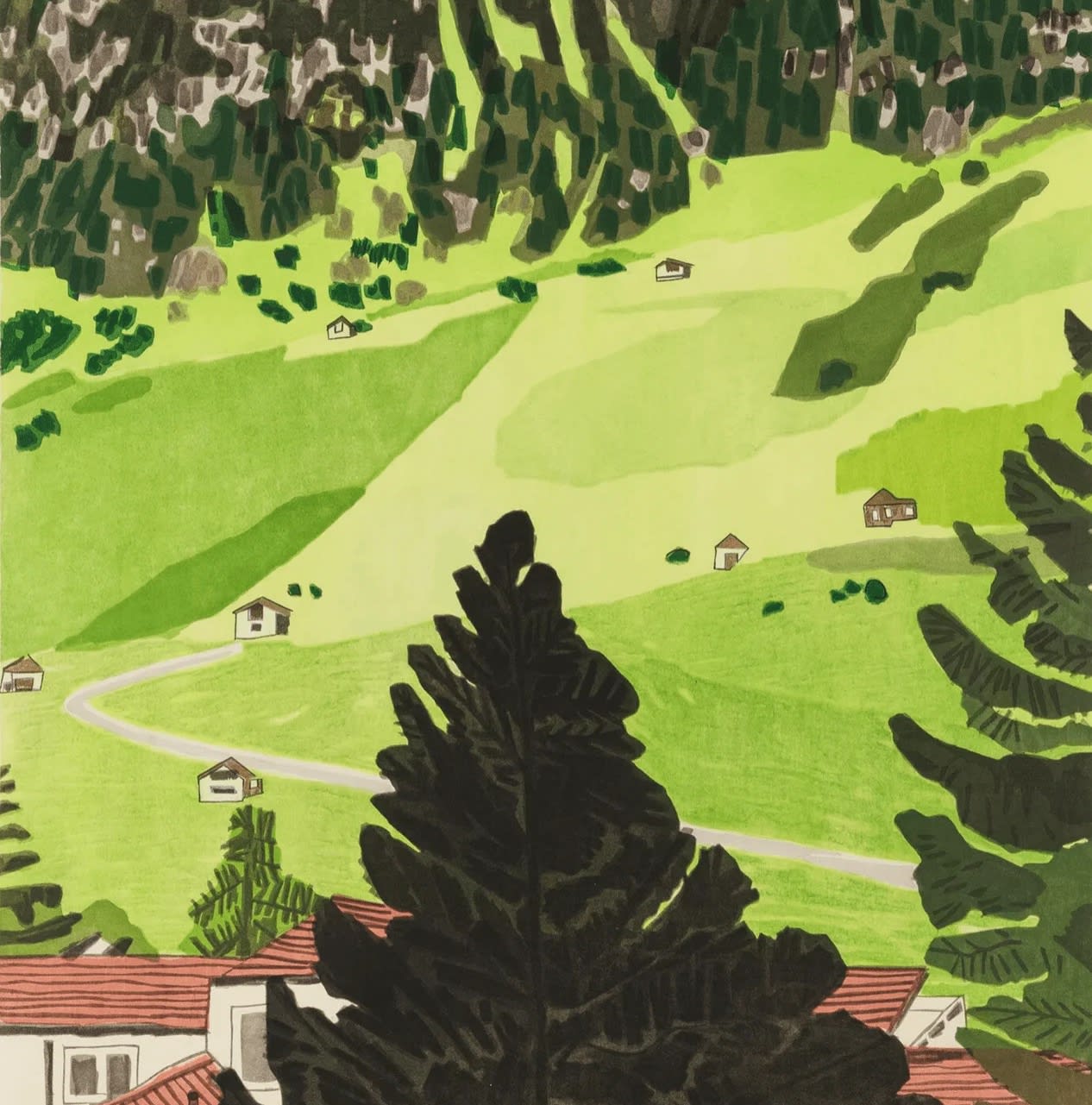Jonas Wood's work stands as a vibrant testament to contemporary painting's potential for stylization, pattern, and detail. Known for his use of bold colors, geometric forms, and flat perspectives, Wood's pieces combine elements of domestic interiors, flora, fauna, and sports imagery, creating a distinct aesthetic that's both accessible and sophisticated. His style is informed by a sense of personal connection to his subject matter, which often includes images from his own life, such as his house plants, family portraits, and objects he has collected over time. Through these choices, Wood turns familiar scenes into visually textured, almost mosaic-like compositions.

Wood's technique involves meticulous layering and an intricate play of lines and dots, which contribute to the visual complexity of his work. He approaches his paintings in stages, first creating a preparatory drawing before moving onto the painting itself, a method that gives his work its graphic, almost collage-like feel. For instance, in works like Clipping 2017, his stylization of plant leaves employs lines to construct intricate details, each segment almost forming a puzzle piece in the larger composition. This layered approach allows him to balance realism with abstraction, making each work feel at once familiar and novel.
In exploring Wood's paintings, it becomes clear that dots and lines are not merely stylistic choices but integral to the texture and rhythm of his work. His use of dots, particularly in his botanical pieces allow viewers to experience the same textured complexity he perceives in nature. These dots do not simply sit on the surface but work in tandem with other layers to build depth and enhance dimensionality. Meanwhile, the lines serve as structural components, outlining shapes and demarcating sections that blend into the larger, cohesive whole.

One striking example of Wood's technique can be seen in Japanese Garden 3 2019, where dots and lines form a delicate but ordered chaos. Here, Wood uses fine, deliberate lines to map out the structure of his subject matter, while dots add a tactile quality, echoing traditional Japanese patterns. This interplay of shapes and textures invites viewers to examine the painting's surface and lose themselves in the subtle, repetitive elements. It's a composition that vibrates with energy while conveying a serene stillness - a balancing act Wood masterfully achieves by focusing on these rhythmic details.
Beyond the dots and lines, Wood's stylization of form is equally compelling. His flattened perspective, reminiscent of both Henri Matisse's work and Japanese woodblock prints, avoids conventional depth and volume, lending his scenes an abstracted quality. This approach is observed where flat shapes convey dimension through color variation rather than shadowing. Wood uses bold contrasts and nuanced lines to distinguish different textures, creating a vivid, three-dimensional impression on a two-dimensional surface.

Wood's focus on interiors and still lifes speaks to his fascination with the personal and the domestic. In his pots series, which includes works like Large Shelf Still Life 2017, he merges his interests in portraiture, interior space, and abstract patterning. The pots themselves become almost character-like, imbued with a presence and vitality. Through the repetition of certain shapes and textures, Wood turns these everyday items into icons of contemporary life. Each piece in the series plays with lines and dots, whether in the patterns on ceramic surfaces or the delicate contours of plant leaves.

His process, involving both printmaking and painting, contributes to the distinct graphic quality of his work. Printmaking, particularly, allows him to experiment with repetition and variation, further refining his approach to line and pattern. Wood often revisits themes or subjects, as in his Landscape Pot series, allowing subtle variations to emerge through different applications of color and linework. This repetition creates a sense of continuity across his body of work, showing how minor shifts in texture or color can transform a familiar scene into something entirely new.
Jonas Wood's paintings embody the power of simplicity paired with detail. His strategic use of dots and lines makes his art visually intricate, yet instantly recognizable, appealing to both minimalist tastes and those who appreciate complex, layered compositions. In capturing the world through his unique stylization, Wood not only portrays his surroundings but invites viewers to reimagine their own, seeing beauty in the patterns, textures, and rhythms of everyday life. His work reminds us that art, in its most elemental forms of line, color, and shape, can still surprise and captivate.
Explore our collection of Jonas Wood prints and contact info@guyhepner.com for further informaiton or to sell your Jonas Wood prints.

